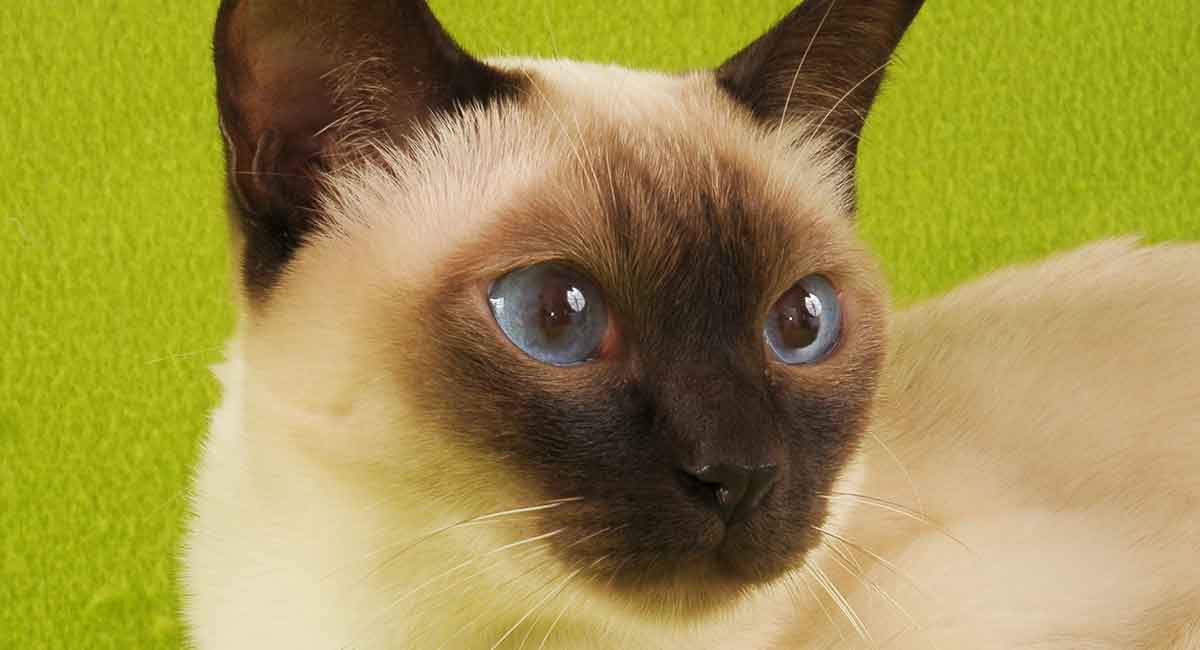
The Tonkinese cat is smart, active and athletic. Originally a Burmese Siamese mix, they are now a breed in their own right. Weighing in at about 4kgs on average, Tonkinese cats have pointed face mask, ears and feet, with a short, neat coat in a range of colors. These cats are sociable and healthy. Today we’ll uncover the origins of the Tonkinese cat breed and share what makes them great pet cats. We’ll help you adopt, raise and care for a Tonkinese kitten, and help them live a long, happy life with you.
Contents
- Where do Tonkinese cats come from?
- Is the Tonkinese cat friendly?
- How big are Tonkinese cats? Weight, height and size
- Tonkinese coats and colors
- How long do Tonkinese cats live?
- Feeding your Tonkinese
- Are Tonkinese cats good pets?
- Tonkinese breeders and kittens
We’ll look at what you can expect from full grown Tonkinese cats in terms of their size, temperament, personality and breed traits. As well as looking at the grooming and shedding needs of this cute house cat.
Tonkinese Cat FAQs
Our readers’ most popular and frequently asked questions about the Tonkinese.
- Are Tonkinese cats good family pets?
- Are Tonkinese cats noisy?
- Is the Tonkinese cat hypoallergenic?
- Are Tonkinese cats affectionate
What is a Tonkinese Cat?
Tonkinese cats have an interesting history that is both long, and short. Put simply, Tonkinese cats were created by breeding Siamese cats and Burmese cats together. The idea is nothing new – kittens of Siamese and Burmese cats have been described in Far Eastern poetry since the 14th century, and they’ve cropped up here and there ever since.
That’s their long history. Modern Tonkinese cats have a much shorter history. The Tonkinese pedigree as we know it today was conceived by Canadian breeder Margaret Conroy in the 1960s. Conroy set out to create a cat which embodied all the best attributes of Siamese and Burmese cats, and looked a bit like both, without the exaggerated features of either.
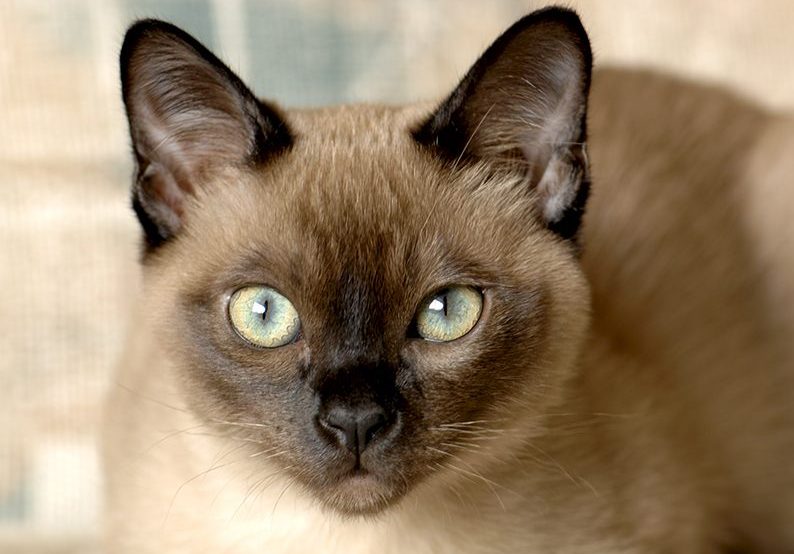
Tonkinese Cat History
When cats of different pedigrees are mated together, their kittens and grand-kittens inherit traits of each breed at random. But through careful selection, the breeding program started by Conroy began to produce Tonkinese cats that “bred true”.
Breeding true means that when two Tonkinese cats breed together now, their kittens will look and behave in a predictable “Tonkinese” way. At this point out-crossing with Siamese and Burmese cats was phased out, and Tonkinese cats began to gain recognition from breed registries in their own right.
The Tonkinese cat was first recognized by the Canadian Cat Association in 1971, the Cat Fanciers’ Association in 1974, and The International Cat Association in 1979. From designer animal beginnings, Tonkinese cats were finally recognized by all the major breed registries in 1990.
Tonkinese Cat Personality
The Tonkinese cat’s owners LOVE to describe all the wonderful things about their cats’ personalities, and it’s easy to see why. Because Tonkinese cats have loads of great qualities!
These cute cats are active and playful, and their mischievous adventures are guaranteed to fill your home with giggles. They’re also charismatic leaders. No Tonkinese cat owner would claim to be the boss in their own home any more (but none seem to mind!)
Do Tonkinese Cats Like Kids?
Above all else, Tonkinese cats adore company. They are full of love and affection for everyone they meet, even children, strangers, and other animals. This makes them the perfect breed for you if the stereotype of cats being aloof and solitary has put you off in the past. Or if you have children and other pets at home.
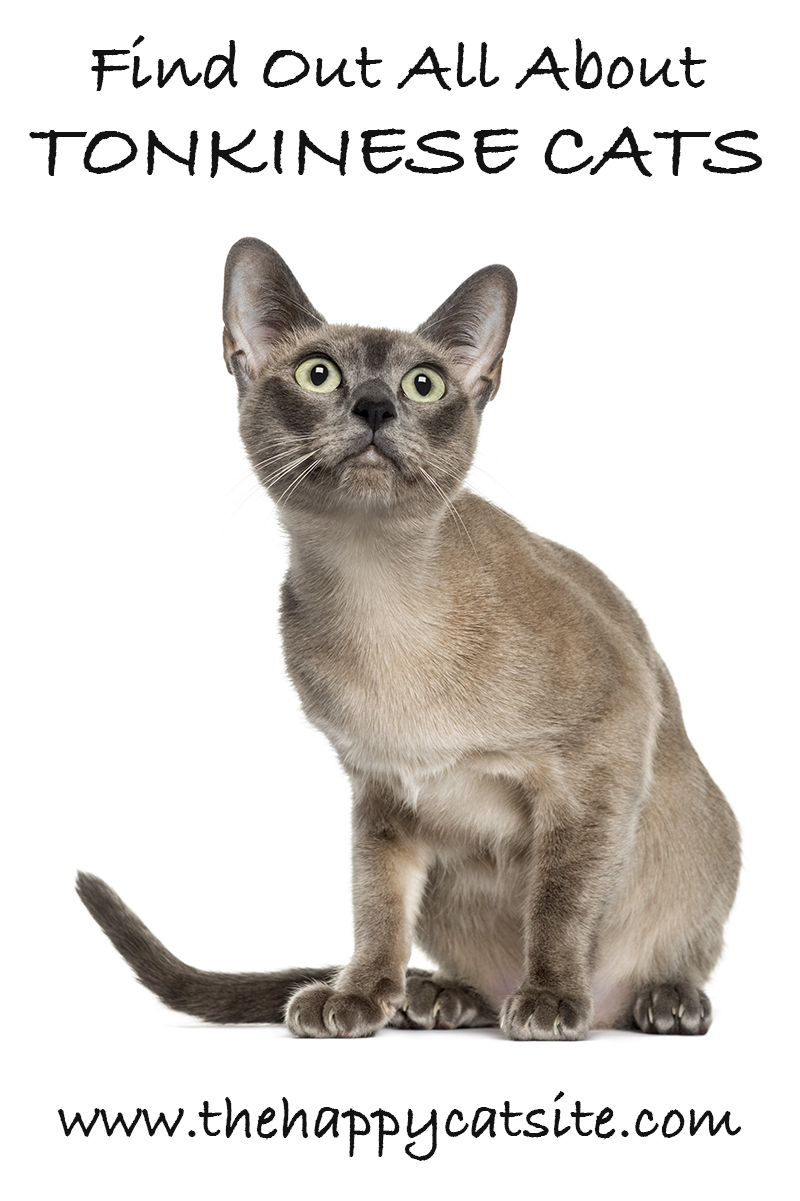
Tonkinese Cat Temperament
If Tonkinese cats have a motto, it’s “everything in moderation”. They are chatty, but not so vocal they’ll drive you to exasperation. They’ll amuse you with their games, but settle down for a cuddle whenever you have time.
But, because Tonkinese cats live for companionship, they will eventually get bored and frustrated if they’re left at home on their own all day. Intelligent and resourceful, their mischievousness can over-spill into naughtiness when they’re lonely.
Keeping them in pairs from kittenhood will go a long way to helping their behavior. But if work requires you to be out of the house all day, then a more independent and self-sufficient breed might be a better cat-match for you.
Can Tonkinese Go Outside?
There is nothing to suggest that a Tonkinese cat can’t be an outdoor cat. Whether you want to have a cat who can roam free outside is up to you in this case.
The Tonkinese has a normal, active hunting instinct and will likely give chase to smaller animals it considers prey. Some consider free-roaming domestic cats to be a threat to local wildlife. However, others believe that a cat’s predatory nature is an important factor in a healthy animal ecosystem.
Tonkinese Size
Tonkinese cats are often described as being heavier than they look. Despite being a small to medium sized breed, they tip the scales at about 4kg (9lb) on average.
That’s because they carry lots of muscle on their small frame. Which gives them their distinctive thickset appearance – or “cobby build” in pedigree animal parlance.
Coats
Tonkinese cats are a truly kaleidoscopic breed. They come in a wide spectrum of muted and pastel tones. Including silvers, grays, taupes, browns, caramels, lilacs and blue.
Some inclusive registries recognize all their possible colors, but the most exclusive registries still only recognize four colors. These include Natural, Blue, Champagne and Platinum. Somewhat confusingly, Tonkinese colors don’t refer to the main color of their body, but the color of their “points”.
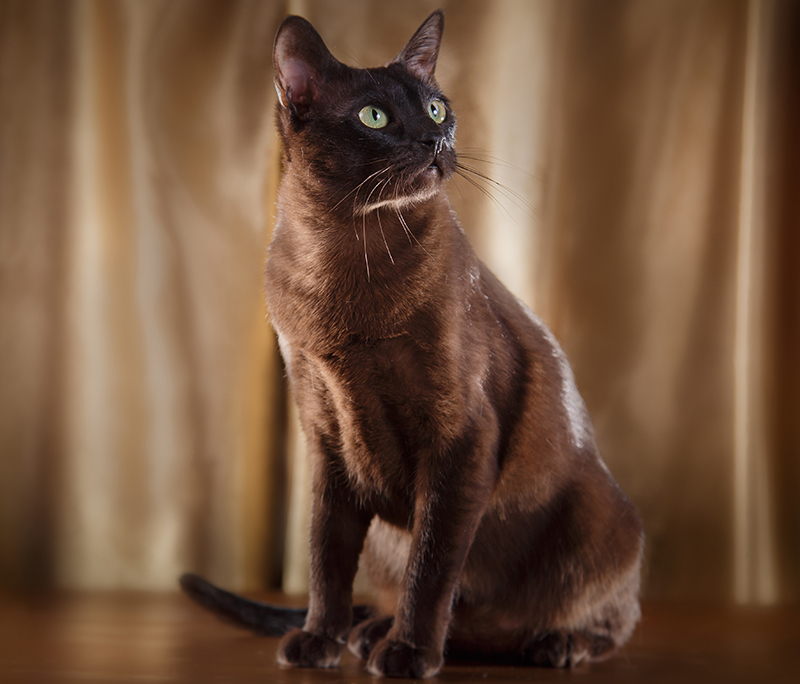
Blue Tonkinese vs Blue Point Tonkinese Cat
Points are the places at the nose, ears, paws and tail where a Tonkinese’s coat is the darkest. Point markings are remarkable because the pigmentation in these places is temperature sensitive. They are dark because the temperature of the skin is lower, which drives more pigment production.
Tonkinese cat coats can either be Point (high contrast, where the body color is much lighter than the color of the points), Mink (medium contrast between the points and the rest of the coat), or Solid (low or no contrast between the color of their points and the rest of their coat).
So a Blue Point Tonkinese cat will have Blue points (a sultry slate-gray, not actually blue!) and a pale creamy-gray body. A Solid Blue Tonkinese will be slate-gray all over. And a Blue Mink Tonkinese will have slate-gray points, and a medium-gray body.
Tonkinese Coat Colors
If you’d like to find out more about how Tonkinese cats inherit their coat color, the Tonkinese Breed Association has a detailed explanation of Tonkinese coat genetics. They also have a fun table for predicting Tonkinese kitten colors.
Tonkinese cat colors take a while to develop and reach their final appearance, and keep evolving throughout a cat’s life.
The Cat Fanciers’ Association Breed Standard allows 16 months for development of full body color, and allows for colors to darken with age.
Grooming your Tonkinese
Are you thinking about getting a Tonkinese cat, but worried about how much grooming they’ll need? Tonkinese cats are a short haired breed, with a neat coat. They’ll enjoy some help with grooming once a week or so, but on the whole their coat is low maintenance.
If you were hoping to find a long haired Tonkinese cat, then you might be interested in Balinese cats or Himalayan cats (originally a Persian x Siamese hybrid) instead.
Best Brush for Tonkinese Cat
Tonkinese cats don’t need much grooming, but unlike other breeds that fight you every step of the way, they love the attention of having their coat brushed for them (oh the irony!) A rubber grooming paddle like this one from Pixikko* (paid link)will massage their skin as you as you go, for the ultimate spa-like treatment.

Tonkinese Shedding
Fortunately for those of you worried about cleaning up endless amounts of cat hair, the Tonkinese is a low shedding breed. Its short coat is easily kept and doesn’t require any special care.
Are Tonkinese Cats Hypoallergenic?
Tonkinese cats are just one of the breeds that have mistakenly described as hypoallergenic. Cat allergies are triggered by Fel D 1 protein in cats’ saliva. As cats wash themselves they shed hair and dander coated in saliva. This leads to the Fel D 1 protein becoming airborne as the saliva dries.
There are no breeds of cat that don’t produce any Fel D 1 protein, So no truly hypoallergenic cat exists. Some allergy sufferers report that short-haired, low shedding breeds like Tonkinese are easier to tolerate. However, there is a complex biochemistry to allergies which we don’t fully understand.
If you or a family member are allergic to cats, spending some time at your breeder’s home is the best way to find out how you’ll react to their cats.
Tonkinese Health
So, we know that this breed was created by mixing two pre-existing pedigrees. Normally we would tell you that the new hybrid could experience any of the health concerns associated with either of their parent breeds.
To be on the safe side you should hope to find a breeder who rigorously health tests their kittens. However, it’s interesting to note that UK charity PDSA keeps detailed information about breed specific health problems for pedigree cats. And they list “nothing specific” for the Tonkinese.
Tonkinese cats owe their robust good health to the careful breeding choices of the people who founded the breed – they are lucky cats.
Like all breeds of cats, Tonkinese cats do need vaccinating. Make sure they have shots against cat flu, feline infectious enteritis, and feline leukemia virus. This is in addition to regular treatment for worms and fleas.
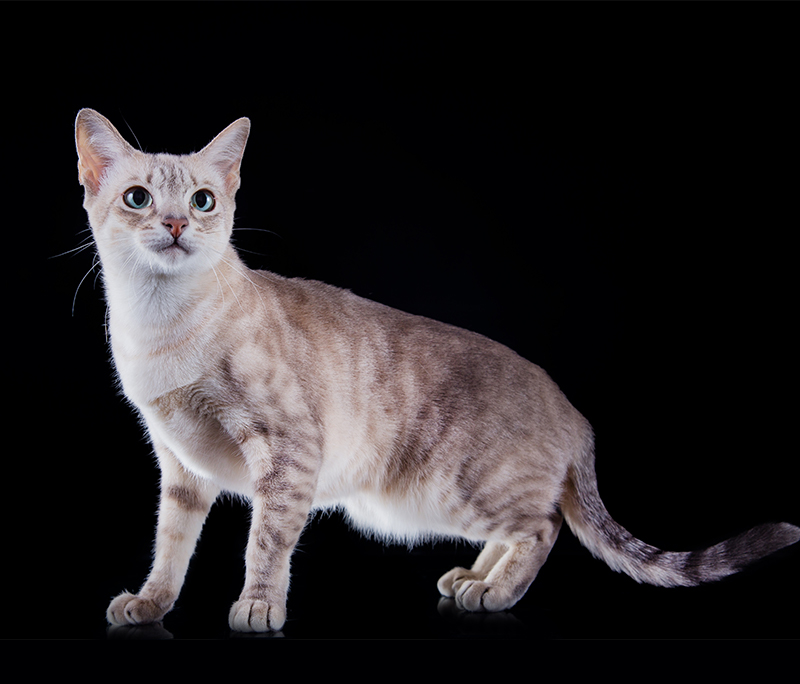
Diabetes in Tonkinese Cats
A study at the Royal Veterinary College in 2016 found that Tonkinese cats do have an increased prevalence of diabetes compared to crossbred cats. However, due to historical breeding policies, the UK Burmese cat population has a much higher rate of diabetes than the American Burmese cat population.
It is unclear whether the UK Tonkinese cat population inherited their risk of diabetes through out-breeding with UK Burmese cats when the breed was being founded. So it may not be a problem that affects US Tonkinese cats, but the research doesn’t exist yet.
Tonkinese Cat Eye Problems
Tonkinese cats’ eyes are their stand-out feature. They’re the only pedigree that can be registered with “aqua” eyes – a beautiful, unusual, green color.
The color is striking, but harmless. Tonkinese cats are no more predisposed to eye-problems than any other breed.
Tonkinese Lifespan
With a bit of luck and proper care, Tonkinese cats typically live to around 15 years old.
This is a respectable age for a pedigree cat, and places them firmly in the middle of the range across all pedigree breeds.
Feeding your Tonkinese
When you bring a Tonkinese cat home, they will already be used to the food they were eating at their previous home. Continue feeding them this and if you want to make changes, do so gradually.
As Tonkinese cats are generally healthy, it’s unlikely they will need a specialized diet.
They do have a high prey drive though, so if they’re allowed outside you might find that they catch plenty of meals themselves!
Dry Food vs Wet Food
You might be wondering whether your new Tonkinese should eat wet or dry food. The truth is there are benefits to both. For example, wet food has a higher water content. So, you can rest easy that your Tonkinese is staying hydrated.
On the other hand, kibble comes with varying ranges of nutritional benefits and you will likely find one that suits your cat best. You will however, have to make sure your cat is getting his fill of water too.
As the Tonkinese doesn’t have any special requirements, you should be able to feed your cat either.
It’s always worth consulting your vet before changing your cat’s diet. Your vet can test for any intolerances your Tonkinese might have.
Are Tonkinese Cats Good Pets?
There are no major health concerns that would make a Tonkinese kittens or a Tonkinese adult a bad choice as a family pet.
These cats are friendly, they love company and they love to chat. They should get on well with other pets and might not be as standoffish as other cat breeds!
Tonkinese Cat Price
The price of a pedigree Tonkinese varies hugely by the area you live in, as well as whether you have your heart set on a particular color.
If there aren’t many breeders operating in your area, the price of a Tonkinese kitten can easily tip over $1,000, and even reach $1,500. If supply and demand are more closely matched, the price will be lower.
Tonkinese Cat Breeders
One of the most important things you can do when looking for a new pet is to be careful where you get the animal from. We strongly recommend that you avoid pet stores and anything that resembles a kitten mill.
Animals from these places are not treated properly. This goes for both the kittens and the parents. Make sure you find a breeder who properly health checks their kittens. Your breeder should be happy to field any questions you might have and must understand the importance of socialization of kittens.
Fortunately Tonkinese cat breeders are a tight-knit and exacting community. The Tonkinese Breed Association is very well organized, and their website includes lots of contact information for Tonkinese cat breeders.
Tonkinese Kittens
The popularity of the Tonkinese breed means that many Tonkinese kitten litters will have been promised to waiting buyers before they are even born, and never listed publicly for sale. To bring a Tonkinese kitten home, make contact with breeders near you, and ask to placed on their waiting list.
Caring for a vulnerable kitten is a big responsibility. Make sure you check out our guide to litter training, socialization and coping with biting. You might also want to consider reading The Happy Cat Handbook.
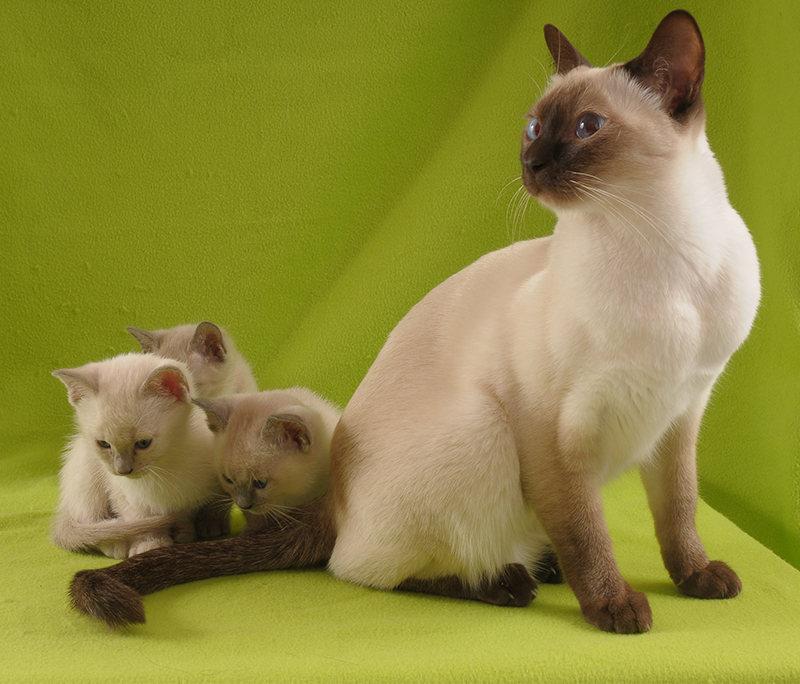
Rescuing a Tonkinese
Tonkinese cats don’t often arrive in rescue shelters, but it does happen, for example if their owners have a dramatic change in circumstances, or pass away. Be aware of Siamese and Burmese cross cats that are advertised as Tonkinese kittens.
First generation kittens of Siamese and Burmese kittens will have an unpredictable combination of traits from each of their parents. This isn’t necessarily a bad thing, but isn’t a Tonkinese either.
Alternatively, some breeders do offer retired breeding cats as pets for a discounted price. You’ll have less time with these cats, but you’ll know exactly what personality they have when you bring them home. Also, they might be calmer than a high-octane Tonkinese kitten.
You can find a list of Tonkinese rescues at the bottom of the page.
Tonkinese Mixes
Torn between the charms of a Tonkinese and the lure of another breed? Then you might be interested in Tonkinese cat mix, for example a Persian Tonkinese cat.
Tonkinese cat breeders are rightly proud of the Tonkinese cat breed, and passionate about carrying on the legacy of breeding healthy cats, whose temperaments are exactly right.
As a result, many Tonkinese kittens are sold either already neutered/spayed. Or even with an obligation that their new owner neuters/spays them straight away without breeding them.
This means Tonkinese cat mixes are particularly uncommon. Where they are advertised occasionally, it invariably seems to be the result of an accidental mating, and the father might be completely unknown.
Pros And Cons of Getting A Tonkinese
Cons
- Tonkinese in the UK may have a higher prevalence of diabetes
- Can be destructive if not adequately stimulated
Pros
- This is a robust breed with few health problems
- Tonkinese cats are affectionate and will love your company
Should I get a Tonkinese?
Tonkinese cats are proof that conscientious breeding programs can create new pedigrees that are beautiful, healthy, and have wonderful personalities. For me, Tonkinese cats aren’t just enchanting pets, but also a fascinating history lesson in how so-called “designer animals” can transition from being controversial to widely accepted.
Unethical breeders chasing quick profits give hybrid breeds a bad name, but none of our domestic cats descended from their wild ancestors by accident. They have all been visualized and coaxed into being by breeders.
Tonkinese cats are robust, fun loving, and companionable. If you have a lot of love to give back, and time to share in their games, then a Tonkinese might be the perfect cat for you.
Do you already have a Tonkinese cat?
Is your house ruled by a Tonkinese?
Please tell us about your experience of owning a Tonkinese cat in the comment section!
Affiliate link disclosure: Links in this article marked with an * are affiliate links, and we may receive a small commission if you purchase these products. However, we selected them for inclusion independently, and all of the views expressed in this article are our own.
Tonkinese Rescues
USA
UK
Australia
References And Resources
- Gough A, Thomas A, O’Neill D. 2018 Breed Predispositions to Disease In Dogs and Cats. Wiley Blackwell
- Hawes et al. Factors Informing Outcomes for Older Cats and Dogs in Animal Shelters
- O’Neill et al. Longevity and mortality of cats attending primary care veterinary practices in England
- Cat Fancier’s Association
- The International Cat Association
- Tonkinese Breed Association (USA)
Tonkinese Breed Club (UK) - O’Neil D.G. et al. 2016. Epidemiology of Diabetes Mellitus among 193,435 Cats Attending Primary-Care Veterinary Practices in England. Journal of Veterinary Internal Medicine.
- Gunn-Moore, D. et al. 2008. Breed-related disorders of cats. JSAP
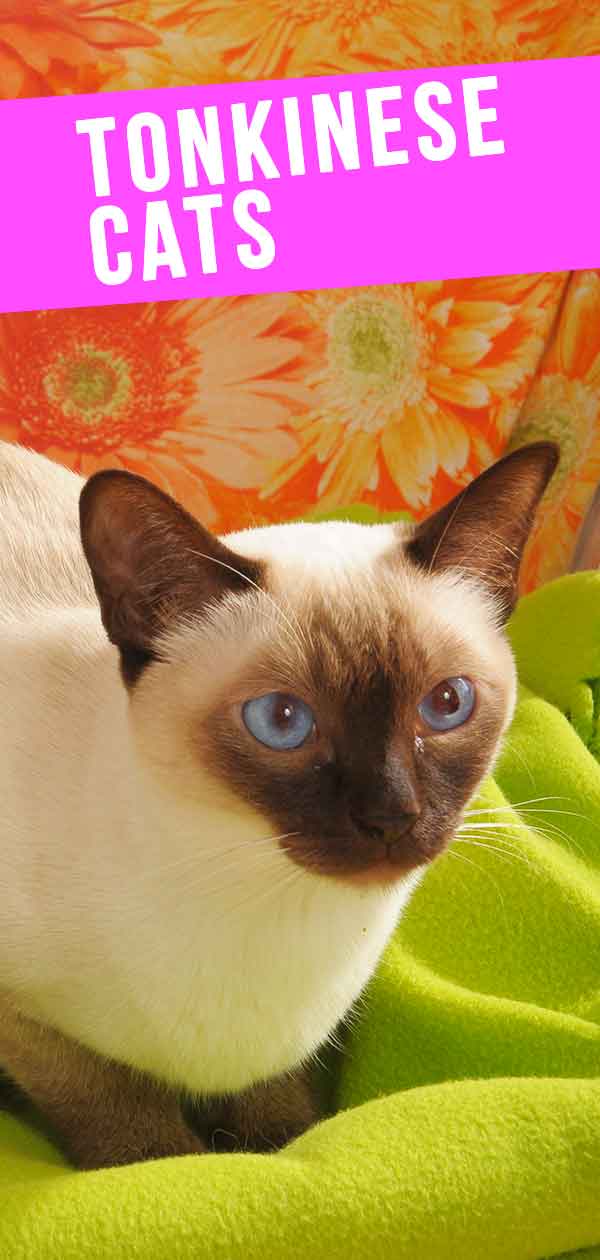

Have a 15 year old Tonkinese, named Lizzie. She is a beautiful cat. She is my first cat. We have owned her since she 8 weeks old. The only medical
problem she has had is to much protein in her system. She is on a Prescription diet. She is lovable, playful and a pleasure to own. She is a
Champagne mink female. A wonderful cat to own.
What prescription diet is she on? I have a beautiful tonkinese cat who licks her hair off. Vet said it’s allergies and put her on ZD prescription food. It helps but still does licking. I would love to know if there is a better diet
Have a 15 year old Tonkinese, named Lizzie. She is a beautiful cat. She is my first cat. We have owned her since she was 8 weeks old. The only medical
problem she has had is to much protein in her system. She is on a Prescription diet. She is lovable, playful and a pleasure to own. She is a
Champagne mink female. A wonderful cat to own.
I have a 4 year old boy who also struggles with protein. His liver ALT tends to be a bit high, so we have him on prescription hydrolyzed food. He seems to do well on it, but is always asking for food! Not sure if he is truly hungry or just likes to talk in the kitchen. I’m so glad to hear that your girl is 15! Zander is a platinum mink with aqua eyes and I hope that he is with us for a very long time.
I have a female much love tonk and she is 17 in one week. Still plays like a kitten and the boss of the house.
My granddaughte’s Tonkinese is 1 year old and is all of the above. She also has a ravenous appetite and hassles me endlessly, every ime I enter the kitchen, even when she has just been fed. Is this normal and how do I curb these demands?
When I leave the kitchen, she will follow to the lounge room and sit beside m on the couch only to jump up and follow me as soon as I get up
My 4 year old boy does the same! He is always hungry and very comfortable talking about it.
I’d like if someone could email me. I’m pretty sure my cat is Tonkinese but unsure!
If anyone specialises please email me so I can send pictures.
Been told before he looks very unusual.
Just rescued 2 Tonkinese brothers (2 years old) from a working family that had no time for them. They are beautiful but very scared of us. Its been a month and a half and they are just starting to come around in the same room. I had been able to pet one for a short time but then he followed his brothers cues of running under the bed when we come near. starting to play with the feather wand , always wants treats, one will take it from my hand but the other one sits back and waits for it to come his way. any suggestions on how we can get them friendlier?
I’m not sure you still have them…They were probably being beaten because Tonkinese cats love people. Just be patient with them and talk to them a lot they will get use to hear your voice and eventually trust you.
Beaten? Lord who beats a cat? They are so small compared to humans. That is just horrible. I hope it’s not the case.
How could anyone beat an animal? I can’t comprehend!!!
A few years ago we started looking after a friends 9 year old Tonk who had been treated cruelly by a flatmate. Not only was he extremely shy, but he would lash out, biting and scratching. It took a few months for him to become comfortable with us. He eventually started enjoying lap time, but we had to be cautious about patting him too much while he was there.
He did settle down, but all-up it took maybe 6 months of calm, non-threatening surroundings. Today he is back with his owner (without the abusive flatmate) and he is a completely different cat – loving and playful.
In fact he had such an impact on us that I am writing this now with a pair of 4 month old Tonk brothers of our own sitting on my lap.
We had a female Tonkinese cat she was 20 yrs old. She had KD since she was 17 and before that she never ever had any health issues. We have her quality food all her life so I’m sure that helped. She was supper affectionate with all of us and was always talkative and she understood me very well when I asked her to do things. She was very smart and sweet and we miss her terribly. We will definitely get another Tonkinese cat since we know that breed very well.
I inherited what I believe is a blue tonkinese.my mother owned him for 4 yrs. but kept him locked in a small bedroom by himself because she had other cats and dogs which did not get along with him.For the last 19 months he has been alone in her house as I have other cats and dogs at my house also which I have been reluctant to introduce him to.He is a great mouse and rat catcher.However he is afraid of people,dogs and almost everything else.He is very different from any other cat she or I have owned and after reading your article about this breed I realize he has every trait described in it.Everyone I talked to suggests having him euthanized but he is such a beautiful cat and I think would make someone familiar with this breed a wonderful pet that I could not do it.The local animal shelter refused him for what they call potential behavior problems.I’ve even tried seeing if he could be an outdoor cat only but he runs back to me and follows me out of insecurity.Perhaps I can find a rescue organization?
My Tonkinese kitten is nearly 6 months old and weighs 2.8 kilos, she is an interesting little girl, doesn’t seem that keen on eating even when she asks for food rarely finishes it but seems to be gaining weight ok. She is a very independent miss loves to be outside which is cat netted. She is very trusting of me, let’s me file her front claws, sits happily to be weighed and was not that worried when I put a harness on her so we can walk , not happy with leash yet. Affectionate but prefers to sleep in her little bed rather than on my lap. She has grey points and pale blue eyes and is very beautiful and dainty, likes to play but expects me to join not interested in mechanical toys. Guess I would like her to interact with me more as chooses where she’ll sleep, has chosen to use the garden pots outside instead of litter tray is very curious about everything and so quick.I wonder if I give her too much attention. She seems quite small and wonder how big she will grow.
Hi all. In this article there are the pictures of cats from my cattery – first is Edelweiss Roxolana Purr-Purr, a blue tabby mink tonkinese female, and also in the part “Tonkinese cat colors” – Edelweiss Yudzhina, a natural solid (sepia) tonkinese female. Welcome to my cattery of tonkinese cats!
I had two tonk brothers or could have been cousins. I got them from someone overbreeding them. Never herd of them before. Both males. In bad shape when I got them, but nursed them back to health. One looked like a choc Siamese, but of course more dainty. I named him Cameo. Did little tricks. Brothers loved playing together typically with a lizard in the middle. Sometimes I felt bad for lizard but got over it cause they had so much fun. I had cats before but these guys were totally different and loving and curious and never grew up.
The other boy was all chocolate like a Burmese, and quite a hunter. I lived on water and got many presents. One he even dragged in and killed right in front of me. Of course, I freaked out but later when I recovered back my sanity, praised him for next few few weeks on his hunting prowess. Cameo died at 6 of a type of cancer. And Cocoa, the Hunter and protector of more timid Cameo started to become super attached to me. People who met him couldn’t believe how beautiful he was. One out of maybe 10 vets could guess what kind of cat he was. Anyway, I could go on forever about him. I love a rescue
We have recently adopted an enormous (10 kg) grey/brown cat. He shares a lot of Tonkinese traits and has beautiful ice blue eyes. He’s very affectionate but can be vicious if he doesn’t get his own way. He definitely likes to be the boss. He rarely speaks and when he does his voice is very soft. I’d like to send you a photo of him to see if you can identify him but I don’t know how to on this page.
I have a 1.5 yr old Tonkenese tabby. His name is Henri and he loves to walk on a leash and ride in a backpack. He travels with us every where and is just a gem.
He’s affectionate and spunky. No health issues but he can be stubborn. You can just pick him up and go. I love him so much!
MY TONK JASPER LIVED 24 YEARS. HE WAS AN INDOOR CAT AND WAS MY JOY. TODAY I HAVE A LILAC TONK NAMED BANDIT AND HE IS GOING ON 10 YEARS . THEY ARE AWSOME PETS.
I have two beautiful siblings, girl is a Blue Mink named and boy is a Blue Point. They will be five years old in this month of August. I got them a seasoned breeder. He had a whole house of every variation of pure crossbred Tonkinese. They have the same mother and father so they are true siblings. I got them when they were about seven weeks old. My girl was shy and would hide all the time. I asked Breeder if that was normal and he said because they were so many other cats in his cattery, she became a little standoffish like that. He encourage me to spend time with her and bring her out of her little shell so she would not be unfriendly or aloof. I did that and it really has worked. She’s definitely my more cautious one with other people visit, but she senses who she can warm up to you. My boy on the other hand is incredibly friendly, affectionate, and very very clingy. I think sometimes he goes to separation anxiety when I’m not around. Then he takes it out on his sister and they ruffle each other up. They never hurt each other. They’re just like kids chasing each other then they find and fight for my lap. My female has incredibly beautiful aqua eyes and my male has big bright blue eyes. If you don’t know about Tonkinese cats, what I learned is that they are incredibly people-oriented cats. They are definitely not your typical cat who can be aloof and detached. They love their humans and they’re very sensitive. I never thought I would love cats as much as I love these two. If any Tonkinese cat seems unfriendly or antisocial, something must have happened to them along the way because by nature, they are very affectionate, loving felines who never get tired of their human family!
My best friend, Ling celebrated her 18th birthday with me 2 months ago. No healrh problems till she had a small stroke at 17.5. I fear i am kosing her now, since she has stopped eating. Best friend i ever had; smart, talkative and loving. I will miss her greatly. Pat
I feel your pain.
I t s do hard to let go
I have a 17.5yo Chocolate Mink Tonkinese named Bombeii.
I adopted her from my neighbours when she was 14 as they were emigrating. They wanted to take her but felt the quarantine period and travelling would be too much for her and she already knew me from when I used to look after her whenever they were away.
She’s a gorgeous little diva who’s totally the boss of the house. So affectionate and chatty, Everything I love in a cat. I adore her so much!
She’s had arthritis in her back legs since just before she came to live with me and has recently been diagnosed with Kidney disease, not that you’d know she had either! Like other Tonks, she plays like a kitten and bounces around the house following me like my little meowing shadow.
We have two Tonk sisters, now aged 5. We live in the UK. Our Tonks are an absolute delight. They love to be where you are and ‘help’ you with whatever you are doing. Mine are like little shadows. My husband tells me they watch for me to come home from windows, or hear my car, and then run to wait for me by the door. They love their cuddles. I would definitely recommend getting two siblings to grow up together, as they absolutely love playing and chasing round with each other and cuddling together to sleep and I think they would be bored otherwise. We were told by our breeder to not let them out, as they have no road sense and lots of Tonks lose their lives that way. We have managed to cat=proof our garden and they are very happy. They are very intelligent. One of them loves to hide before bed-time yelping excitedly as I get near her hiding place and purring when I find her to give her a special cuddle!
One of them has had two bouts of pancreatitis which apparently is a risk with orientals. But thankfully mild and now we know the signs; she went quiet and withdrawn.
We recommend our breeder. The cats live with her in her home. She takes great care and is very knowledgable and has bred champions too. http://www.tonkyway.co.uk
I have a 9YO Platinum Mink girl named Kaylee, and a 6YO Bluepoint named Quigley. Since I lost my wife, I don’t know what I’d do without them. We got Kaylee when we lost our previous Blue Mink, named Gunner. Gunner’s littermate, Max, whom we also had didn’t care much for the little ball of fire, Kaylee, at first, but inevitably caved in to her sweetness, and he being a Platinum Mink also, they looked like Uncle and Niece, which they likely were. When Max was 15 we got Quigley, as we were thinking about Max’s mortality. Max though, hung on to 18, and was vibrant to the last week or so, when he started falling and his eyes told us it was time. He was a wonderful cat-the perfect pet, same for his brother, lost to cancer on his 13th birthday, and the ultimate reasons we stayed with the Tonkinese breed. They do steal your hearts, and become family quickly.
I have 2 Tonk sisters Lily & Cami and 2 Tonk brothers Gustave & Ike.
Ike. The most wonderful cats ever!! Gorgeous & so intelligent! I show them and have won a lot.
I have a 5 month old who I believe is a platinum mink tonk. He exhibits many of the Tonk chracteristics as above. He is super playful and plays fetch. Again, everyone is obsessed with how beautiful he is. If someone can verify that he is in fact a Tonk, that would be super helpful! We have been researching and guessing for months – since we got him! We love him very much! I included a link so you can see pictures.
My ashes is 5 years old I have had him since he was 2 and a half weeks old I bottle fed him too he still likes milk (as a treat )on his birthday he’s quite the mommy’s boy and quite the entertainer haha string eaten here bug there and don’t forget the plastic squishy frogs how in the world is this cat alive I don’t know but currently he’s doing great
My natural mink Tonkinese is such a joy. Energetic, playful, talkative, demanding and lovable. How lucky I am to have her in my life. Minka’s sister is a shiba inu named Amber and they tease and play with one another. Minka’s favorite toy is a small stuffed animal that she tosses in the air and then pounces on until Amber grabs it! And, she loves to sleep under the covers in Mom’s bed.
Kitty is a lilac tonk. She’s assertive but incredibly sweet. No health issues at 12 yrs old but needs prescription food. Loves to snuggle with me and goes for walks on the lead. She is loved and I cherish her.
Hi there, I am looking for someone who can confirm if I have a tonkinese or not. Is it possible for an email address to be supplied where I can email a photo to?
I am from South Africa, and never hrard of a tonkinese until a friend told me that my cat is a tonkinese.
Griffin is my fifth Tonk. I got him from the breeder when he was 5 months old.
He’s a wonderful cat, very affectionate and cuddly.
However, he is very prone to chewing everything. I cannot take him to the vets at the moment because of my age and CoVid. They have suggested I try a Feliway diffuser. I’ve ordered one.
Im interested in hearing from anyone else who has a Tonk with this issue who has had success in correcting it.
We have a Bumese-Ragdoll cross (16 years old), a pure Ragdoll (half sibling of the other cat and NOT a typical Ragdoll, also 16 years old) and a Tonkinese who is 15 and a half. We used to have another Tonkinese from the same litter but she got sick and we lost her last year at 14 (she loved our Burmese-Ragdoll so much and followed him everywhere). Out surviving Tonkinese is aggressively affectionate, giving my wife and I more cuddles than you’d think possible (yet she hides behind the bed if someone she doesn’t know comes to our house). We feared we were going to ltose our surviving Tonkinese this year when she got poorly, but a couple of months with a feeding tube fitted and with us giving her special care, she’s now back to normal. She is awesome. Aside from her name, her nickname is “monster” because of how demanding of attention she is… I’m so pleased she has recovered to give us more time with her.
I have a nine year old male Tonk who, since he was a kitten, was always with my ginger tom (a year older). Sadly I had to have my moggie ginger boy put to sleep due to feline coronavirus yesterday and my Tonk seems very lost without him (they used to cuddle up together etc). However, my Tonk is very territorial of other cats and has bullied a young female tabby of my near neighbour’s. My question is: should I get a kitten a little later on or will he not accept it? I used to feel that he didnt want to share his ginger friend with another cat (the girl kitten used to like my ginger) so am not sure how the dynamics will work now that he is completely on his own.
Our tonk Pushki was from the pound. She is a gorgeous playful loyal bossy affectionate girl and did I mention talkative????
She is ruling the house . Loves a walk in a harness and leash.
She can be a little aggressive if she doesn’t get her own way.
She is the most loyal cat I’ve ever owned and follows me everywhere.